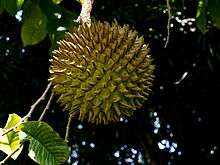Annona purpurea
| Annona purpurea | |
|---|---|
 | |
| Scientific classification | |
| Kingdom: | Plantae |
| Clade: | Angiosperms |
| Clade: | Magnoliids |
| Order: | Magnoliales |
| Family: | Annonaceae |
| Genus: | Annona |
| Species: | A. purpurea |
| Binomial name | |
| Annona purpurea Moc. & Sessé ex Dunal | |
Annona purpurea is an edible fruit and medicinal plant in the Annonaceae family. It is native to Mexico, Central America, and parts of South America. Its common names include soncoya, sincuya, and cabeza de negro. It is a small to medium tree reaching a maximum of 6 to 10 metres (20 to 33 ft). It is deciduous with hairy leaves and large, strong-scented flowers.[1]
The fruit is rounded, 15 to 20 centimeters wide, and covered with a felt-textured brown skin that is hard to cut open when ripe. The surface of the fruit has hooklike projections. It has many seeds which have a germination time of 1 to 6 months. Trees take about 1 to 3 years to bear and can be container grown. This species is closely related to the cherimoya, the sugar-apple and other Annonas. The soncoya is fairly obscure among Annonas; the fruit is of indifferent quality and has not attracted wide cultivation.[1] The fruit has a texture like the soursop which some may describe as stringy or fibrous.
References
- 1 2 Morton, Julia F. (1987). "Soncoya". Fruits of Warm Climates. Miami, FL: J.F. Morton. p. 85. ISBN 0961018410. Retrieved 9 April 2013. Online at Purdue University Center for New Crops and Plant Products.
External links
- Annona purpurea at University of Connecticut, Ecology & Evolutionary Biology
- Soncoya at Trade Winds Fruit
- Soncoya at Fruitsinfo.com